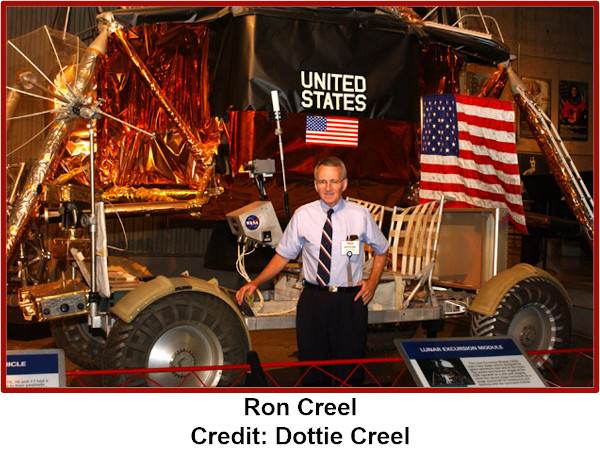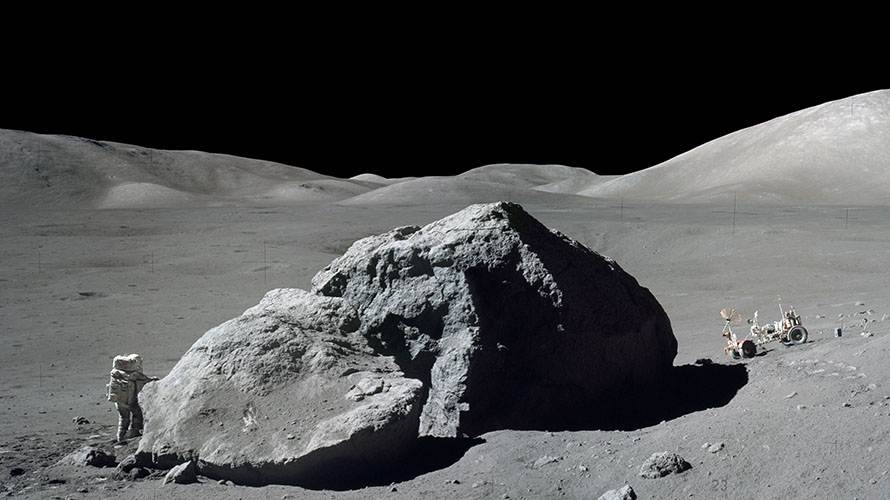By Robin Scott
The Sacramento L5 Society (SacL5) Chapter of NSS wrapped up its successful series of 50th anniversary “Breakfast on the Moon” (BOM) events last December 10. The entire series of events can be viewed on the Sacramento L5 YouTube channel.
The Apollo missions spanned a three and a one-half year period but affected a whole generation. On the final December 10th event, SacL5 celebrated the 50th Anniversary of the Apollo 17 mission. The celebration was watched around the world. As SacL5 President and moderator Joseph Bland began this event, he reflected that astronaut Eugene Cernan was the last person who stepped off the Moon 50 years ago on December 14, 1972.

Next, Dr. Ami Bera, U.S. Congressman, and Senior Member of the Science, Space, and Aeronautics subcommittee of the U. S House Committee on Science, Space and Technology, congratulated SacL5 for commemorating this historic Apollo 17 anniversary event. He thought on behalf of the Artemis mission, soon there would be a “return to the Moon”; a colony could be built on the Moon; the Moon could be important for the mission to Mars; and lunar ice could be converted to fuel. Bera said “the future of space travel and the future of space exploration is exciting.” “Let’s inspire the next generation,” “to think big broadly, to think about Mars, but to think what is out there in our galaxy and beyond our galaxy.”
Dr. Anthony Paustian, Vice President of the National Space Society, College Administrator, Author, and previous Air Force Fighter Pilot, painted a picture of astronaut Alan Bean’s perspectives from his discussions with him. One remembrance was Bean said he looked at the Earth from the Moon, and thought how good Earth had it in respect to the rest of the universe. Paustian highlighted that Bean said the greatest thing that NASA ever did was create the Agency Contingency plan so procedures were made in advance to save missions. Paustian said Bean recognized the progression at NASA; he saw and appreciated the “doers” of the work, math, science, and engineering that made Apollo happen. This BOM event communicated the reciprocated respect of the astronauts and those who worked on the Apollo missions. Ron Creel, Apollo lunar rover engineer, was noted to have expressed esteem and awe for the Apollo astronauts who drove the lunar rovers on the Moon.

Paustian contacted Gerald Griffin to relay his first-hand accounts of the Apollo Missions as Flight Director during the Apollo program and Director of Johnson Space Center. Griffin told how Apollo 15 mission, astronaut David Scott encouraged him to come along on the astronaut field trips/training to gain perspectives for scientific and geologic missions and later other flight directors and Apollo Headquarter professionals followed suit. Griffin said the missions before Apollo 15 were to safely get to the Moon; but Apollo 15, 16, and 17 focused on why we were going—“to explore the Moon” while keeping safety in mind.
Focusing on Apollo 17, Griffin said not only was Apollo 17 considered the capstone of all of the Apollo missions, but it achieved more time on the Moon, more time on extravehicular activities, and more samples than any other Apollo mission. He said astronaut Harrison Schmitt, Ph.D. geologist, found the rock Trictolite 76535, which proved the Moon once had a magnetic field. Schmitt can be credited for the famous “Blue Marble” picture. Even though Apollo 17 had a problem on the launch pad, and Cernan and Schmitt had to fix the fender of the lunar rover, Griffin considered Apollo 17 a clean mission. Griffin said the Apollo missions were fun and challenging because going to and exploring the Moon had never been done before. He said the Artemis mission will mimic some of Apollo’s steps from safety to exploration, but Artemis has technological advantages such as computer memory size (Apollo Mission—five-IBM 365s within a large area was the same as his current cell phone). He said the Apollo missions did not have the performance to go to the lunar South Pole, but Artemis is going to the lunar South Pole on the first mission.
This event expounded the heart-warming stories of how NSS leaders were inspired by or took part in these Apollo missions. NSS Downlink editor Fred Becker, who has worked on many key space programs, was at the Apollo 16 launch at the age of 16. He shared a video combining launch commentary from Martin Caidin and photographs that he captured from touring KSC and viewing the Apollo 16 launch. During Apollo 17, Gerald Nordley, then a 1st. Lt., contributed as part of a NASA contingency plan that used USAF-managed Vela Hotel satellites to detect possible coronal mass ejections and recall astronauts from the Moon in time to minimize their radiation exposure.
Space publication and communication experts took part in this event with outstanding space perspectives. This Week in Space broadcast hosts Rod Pyle, Editor in Chief of ad Astra, and Tariq Malik, Editor in Chief of Space.com, communicated their viewpoints on the Apollo Missions. Malik gave his interpretation as kid of the space age; he considered Apollo 17 signified “the mission we stopped going to the Moon.” Pyle shared a remembrance of Joe Engle, Apollo 17 astronaut, from his discussions with him. Pyle remembered how gracious Engle was because of his understanding that a scientist was needed when Schmitt replaced him on the last Apollo mission. Pyle also shared his disappointment of the cancellation of the Apollo 18. 19, and 20 missions when the hardware had already been built and the flight operations were cancelled. Malik and Pyle further discussed unique outlooks of Apollo and future Moon missions. An entertainingly witty commentary was made by Christopher D. Carson, former Regional Director for the National Space Society. Carson said the Apollo Missions were to be built upon and propelled his clever perceptions of the future in space.
Preservation of the Apollo sites was explained. Lisa Westwood, Space Archaeologist, and Cofounder of the Apollo 11 task force, said the achievement of first-time milestones are memorialized because they represent important events in human history. Dr. Beth O’Leary, Professor Emeritus of the New Mexico State University Department of Anthropology and Pioneer in Space Archeology and Heritage, said “after 50 years according to the U.S. Historic Preservation law, a place becomes historic and is easier to get nominated to the National Register of Historic places.” Westwood, O’Leary, and their colleagues successfully achieved designation of the artifacts and structures of Apollo 11’s Tranquility Base on the Moon on the California and New Mexico historical registers. Westwood said “This was the first time that a historical site not located on Earth became listed on a historical registry.” O’Leary said “It has been singled out as exceptionally important in the 2011 NASA guidelines to protect this historic and scientific values of American lunar artifacts.”
Anita Gale, CEO of the NSS and retired Boeing engineer who worked on the Space Shuttle, said “as the Artemis mission is returning from the Moon, we are going back, and maybe we needed to wait this long to get it right because now, instead of flags and footprints, we are now planning infrastructure and industry, which is really how it needs to go.” She added NSS is helping make future commercial space, settling of space, and the use of lunar resources through visits with congressional offices, conferences, educational programs, and alliance with other organizations.
Michelle Hanlon, President of NSS, Space Lawyer, and Cofounder and President of For All Moon Kind Inc., said “the Apollo Program is the greatest technological achievement of humanity to date,” and “we reach for the stars not simply because they are there but because the future of humanity both here on Earth and in space depends on our ability to explore and discover.” Hanlon ended with “This has billed as the last breakfast; and certainly, it is the last of our 50th celebrations for Apollo. But let me challenge you to make this the first breakfast of Artemis and a future where humans do not have to be heroes to go to space. Here is to Apollo 17, here is to Apollo, here is to Artemis, and here is to protecting the boot prints and all that Apollo stands for.” Her words lead to where Cernan’s last words on the Moon left an open door for humanity.
“As I take man’s last step from the surface, back home for some time to come (but we believe not too long into the future), I’d like to just say what I believe history will record: That America’s challenge of today has forged man’s destiny of tomorrow. And, as we leave the Moon at Taurus-Littrow, we leave as we came and, God willing, as we shall return: with peace and hope for all mankind.” —Gene Cernan



















